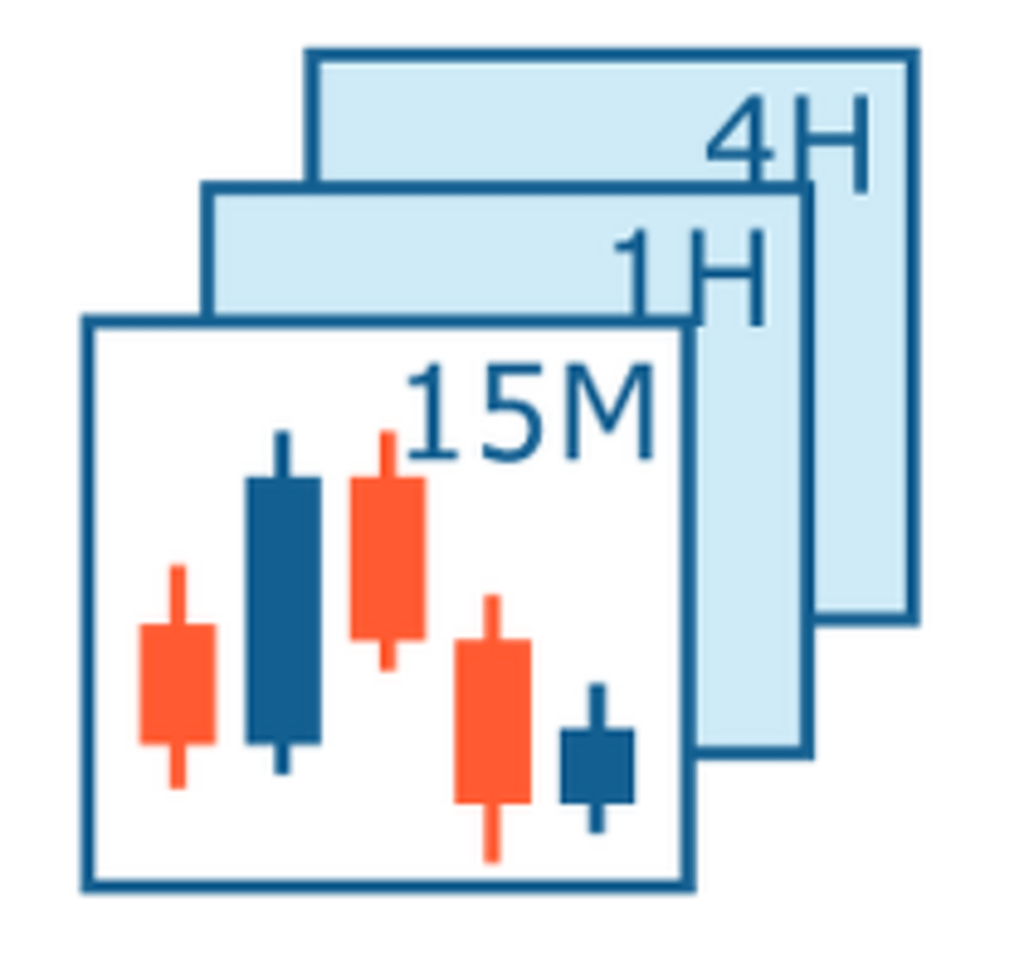Multiple time frame analysis is monitoring a currency pair across different time zones. There are no rigid rules as to what timeframes should be combined, although there are general guidelines that seasoned forex traders use. Seasoned traders combine three time frames; using less than three time frames can result in insufficient data while using more than three can give redundant readings.
Seasoned traders use the ratios of 1:4 and 1:6 when switching between timeframes. When using the ratio of 1:4, that means that if the shortest time frame is 15 minutes, then you should switch four times more, meaning you switch to the 1 hour timeframe. When using the 1:6 ratio, you switch from a 15-minute time frame to the 300-minute timeframe. It is pointless to focus on extremely small time frames since the price movements give little information on the general market trend, and you can get overwhelmed when the market is highly volatile.
Table of Contents
How to conduct multiple timeframe analysis
It would be pointless if I told you about the benefits of multi-timeframe analysis and did not give you guidance on how to set up these time frames. You select the timeframes for analysis according to the amount of time available for trading and the timeframes used most by seasoned traders for winning trades.
- Traders who only have one hour to trade use the one-day frame for analysis and the four-hour charts to note entry points. Traders with more time to trade can analyze smaller time frames because they can act quickly when opportunities present themselves.
- Long term traders whose holding period is more than one day use the weekly chart for trend analysis and the daily chart to find potential entry points
- Swing traders whose holding period is a few hours to a few days use the daily chart for trend analysis and the 4-hour chart to find entry positions
- Short term traders with a holding period of less than a day use the 4-hour chart for trend analysis and the hourly chart to enter positions
- Scalpers whose holding period is an hour or a few hours use the hourly chart for trend analysis and the 15-minute timeframe to enter trades.
Why use multiple time frame analysis
Using multiple time frame analysis reinforces your decisions to either go long or short. Studying Multiple time frames is a top-down analysis that allows traders to see the current market trend. Therefore, the trader enjoys the lowest risk if they trade according to the trend. Actually, most seasoned traders trade according to the direction of the trend. If at all you conduct multi-timeframe analysis, and you notice that shorter timeframes are changing trend direction, you should be cautious about setting up trades against the overall long-term trend because a reversal can occur at any point. Trading against the trend poses a higher risk. Alternatively, the trader can choose to wait for the shorter time frames to align with the general trend so as to enter positions according to the direction of the market.
Conducting multiple time frame analysis helps traders identify important places of value. The traders are able to recognize support and resistance and denote perfect entry and exit levels.
The general concept behind multiple time frame analysis is first identifying the trend in a longer time frame, then looking at the same trend in a smaller time frame. Compare both timeframes to see whether they are aligned. If they are not aligned, the entry point will be when the shorter time frame finally aligns with the longer time frame. You can alternatively choose to trade against the trend when the shorter time frames do not align with the long-term time frame; however, this poses a greater risk than trading according to the trend.
The secret is effectively utilizing fundamental and technical analysis tools and identifying important points of value.
Using the simple moving average to enter trades
The simple moving average is an important indicator of price trends. When the price is above the 200 SMA, the market is considered to be in a long-term uptrend. In this case, the 200 SMA identifies the long-term trend while the 50 SMA identifies short-time price trends. If the price is trading above the 20-day SMA, it is considered to be in a short-term uptrend. The vice versa is true.
A common way to trade SMA is to look for bullish crossovers and bearish crossovers. A bearish crossover occurs when the prices fall below the SMA after trading above it. This crossover is an indication of a trend reversal; it indicates that the uptrend is over and a downtrend is set to start. A bearish crossover signals that you can enter a short trade. Not that this strategy is used only in trending markets. Applying this strategy in sideways or volatile markets is pointless. For instance, a bullish crossover that occurs in a long-term downtrend is not meaningful.
Another way to trade the Simple Moving Average is the SMA crossover, which is essentially when a short-term SMA crosses over a long-term SMA and vice versa. In a bullish market, If the 50 SMA crosses above the 200 SMA, this is a clear indication of a bullish trend, and the presence of high trading volumes can confirm this. This trading setup is known as the golden cross, and it is a sign to go long.
The reverse of the golden cross is the death cross. A death cross occurs when an asset’s short-term SMA crosses below its long-term SMA. If the 50 SMA crosses below the 200 SMA, it indicates a bearish trend, indicating the prices will continue falling.
SMA can also be used to identify support and resistance levels. The SMA acts as support and resistance when an asset in an uptrend pullback once in a while but always goes back to the support at the 200 SMA. Remember to use long time frames to identify trends and smaller time frames to see ideal entry positions.
All the best!

